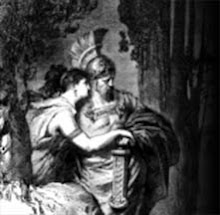A 20th century art movement with its’ roots in Italian and Russian beginnings, Futurism is said to have largely began with the writing of a 1907 essay on music by the Italian composer Ferruccio Busoni, and explored every medium of art to convey its’ meanings. The Italian poet Filippo Tommaso Marinetti was the first to produce an article in which was summed up the major principles that became the Manifesto of Futurism in 1909. It included the passionate loathing of ideas from he past, and with that enmity of political and artistic traditions, espoused a love for speed and technology.
The philosophy of Futurism regarded the car, the plane, and the industrial town as legendary of the technological triumph of mankind over nature. With Marinetti at the helm, a few artists of the time introduced the tenets of the philosophy to the visual arts, and represented the movement in its’ first phase in 1910. The Russian Futurists were fascinated with dynamism and the restlessness of modern urban life, purposefully seeking to provoke controversy and attract attention to their works through insulting reviews of the static art of the past, and the circle of Russian Futurists were predominantly literary as opposed to being overtly artistic.
Cubo-Futurism was a school of Russian Futurism formulated in 1913, and many of the works incorporated Cubism’s usage of angular forms combined with the Futurist predisposition for dynamism. The Futurist painter Kazimir Malevich was the artist to develop the style, but dismissed it for the inception of the artistic style known as Suprematism, that focused upon the fundamental geometric shapes as a form of non-objective art. Suprematism grew around Malevich, with most prominent works being produced between 1915 and 1918, but the movement had halted for the most part by 1934 in Stalinist Russia.
Though at one point, those Russian poets and artists that considered themselves Futurists had collaborated on works such a Futurist opera, but the Russian movement broke down from persecution for their belief in free thought with the start of the Stalinist age. Italian Futurists were strongly linked with the early fascists in the hope for modernizing the society and economy in the 1920s through to the 1930s, and Marinetti founded the Futurist Political Party in early 1918, which was later absorbed into Benito Mussolini’s National Fascist Party.
As tensions grew within the various artistic faces that considered themselves Futurists, many Futurists became associated with fascism which later translated into Futurist architecture being born, and interesting examples of this style can be found today even though many Futurist architects were at odds in the fascist taste for Roman imperial patterns. Futurism has even influenced many other 20th century art movements such as Dadaism, Surrealism, and Art Deco styles. Futurism as a movement is considered extinct for the most part with the death of Marinetti in 1944.
As Futurism gave way to the actual future of things, the ideals of the artistic movement have remained significant in Western culture through the expressions of the commercial cinema and culture, and can even be as an influence in modern Japanese anime and cinema. The Cyberpunk genre of films and books owe much to the Futurist tenets, and the movement has even spawned Neo-Futurism, a style of theatre at utilizes on Futurism’s focuses to create a new form of theatre. Much of Futurism’s inspiration came from the previous movement of Cubism, that involved such famed artists as Pablo Picasso and Paul Cezanne, and created much of the basis for Futurism through its’ philosophy.
Friday, February 29, 2008
Subscribe to:
Post Comments (Atom)




1 comment:
Elegant job ,bringing together Russian modernism, Futurism and Cubism. I was looking for an Italian Futurist who painted something to do with bread, the central topic on my current blog posting
www.foodintherts.blogspot.com
Cheers!
Bill Moore
Post a Comment